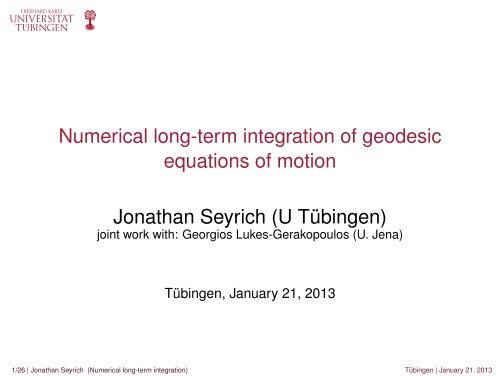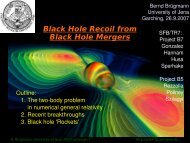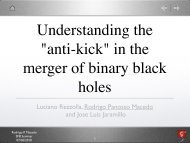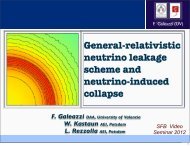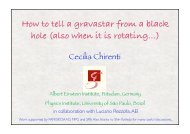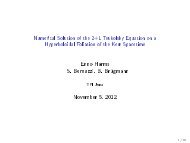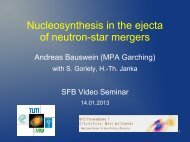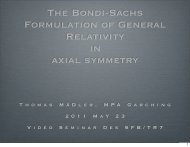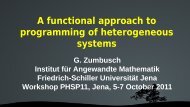Numerical long-term integration of geodesic equations of motion
Numerical long-term integration of geodesic equations of motion
Numerical long-term integration of geodesic equations of motion
Create successful ePaper yourself
Turn your PDF publications into a flip-book with our unique Google optimized e-Paper software.
<strong>Numerical</strong> <strong>long</strong>-<strong>term</strong> <strong>integration</strong> <strong>of</strong> <strong>geodesic</strong><strong>equations</strong> <strong>of</strong> <strong>motion</strong>Jonathan Seyrich (U Tübingen)joint work with: Georgios Lukes-Gerakopoulos (U. Jena)Tübingen, January 21, 20131/26 | Jonathan Seyrich (<strong>Numerical</strong> <strong>long</strong>-<strong>term</strong> <strong>integration</strong>) Tübingen | January 21, 2013
OutlineProblem and motivation<strong>Numerical</strong> properties <strong>of</strong> the <strong>equations</strong>Structure preserving integrator for Geodesic <strong>equations</strong><strong>Numerical</strong> experimentsSummary2/26 | Jonathan Seyrich (<strong>Numerical</strong> <strong>long</strong>-<strong>term</strong> <strong>integration</strong>) Tübingen | January 21, 2013
Problem and motivationGeodesic <strong>equations</strong> <strong>of</strong> <strong>motion</strong>◮ Comparably light particle m 0 in gravitational field <strong>of</strong> heavy central body◮ Described by Lagrangian L = 1 2 m 0g µν ẋ µ ẋ ν◮ Hamiltonian system with H = 12m 0g µν p µ p ν , p µ = ∂L∂ẋ µ◮ Equations <strong>of</strong> <strong>motion</strong> in short form y := (p, x):(dy dp) ( )dτ = −∇x H(p, x)dτ dx == f (y) (1)∇ p H(p, x)dτ3/26 | Jonathan Seyrich (<strong>Numerical</strong> <strong>long</strong>-<strong>term</strong> <strong>integration</strong>) Tübingen | January 21, 2013
Problem and motivation◮ Classical explicit Runge-Kutta method in axisymmetric case:10.01h=0.01h=0.10.010.0050.0001p x01e-006-0.005∆H(t)1e-008h=1h=101e-0100.0051e-0121e-014h=0.01h=0.1h=1h=100 100000 200000 300000 400000 500000tp x0-0.00530 35 40 45 50 55 60x30 35 40 45 50 55 60 65xFigure: Energy error ∆H = | [H(yn)−H 0]/H 0 |.Figure: Poincaré sectionsEnergy conservation is important⇒ Use structure preserving integrators!4/26 | Jonathan Seyrich (<strong>Numerical</strong> <strong>long</strong>-<strong>term</strong> <strong>integration</strong>) Tübingen | January 21, 2013
<strong>Numerical</strong> properties <strong>of</strong> the <strong>equations</strong><strong>Numerical</strong> difficultiesI: Hamiltonian is non-separable⇒ Structure preservingschemes are implicit∥∥ ∂f∂y∥∥ ∂f∂y∥ ≫ 1,∥ ∼ 1,II:for some yfor other y5/26 | Jonathan Seyrich (<strong>Numerical</strong> <strong>long</strong>-<strong>term</strong> <strong>integration</strong>) Tübingen | January 21, 2013
<strong>Numerical</strong> properties <strong>of</strong> the <strong>equations</strong>◮ Appropriate schemes: Gauss Runge-Kutta methodswiths∑y n+1 = y n + h b i f (Y i ),Y i = y n + hi=1s∑a ij f (Y j ),j=1b i =a ij =∫ 10∫ ci0l i (t)dt,l j (t)dt,l i (t) := ∏ i≠jt − c jc i − c j,c i = 1 2 (1 + ˜c i).◮ ˜c i are the roots <strong>of</strong> the Legendre-polynomial <strong>of</strong> degree s.Convergence order O(h 2s ).6/26 | Jonathan Seyrich (<strong>Numerical</strong> <strong>long</strong>-<strong>term</strong> <strong>integration</strong>) Tübingen | January 21, 2013
<strong>Numerical</strong> properties <strong>of</strong> the <strong>equations</strong>Flow Φ h ,y n+1 = Φ h (y n )<strong>of</strong> Gauss collocation schemes preserves (cf. [Hairer et al., 2006]):◮ Symmetry:◮ Symplecticity:( ) T ( )∂Φh (y) ∂Φh (y)J= J, J =∂y∂y◮ Reversibility:Φ −h = Φ −1h(2)( ) 0 Id. (3)−Id 0Φ −1h◦ ζ = ζ ◦ Φ h , ζ(p, x) = (−p, x). (4)7/26 | Jonathan Seyrich (<strong>Numerical</strong> <strong>long</strong>-<strong>term</strong> <strong>integration</strong>) Tübingen | January 21, 2013
<strong>Numerical</strong> properties <strong>of</strong> the <strong>equations</strong>⎛⎜⎝Y 1⎞.Y sScheme is implicit:⎟⎠ =⎛ ⎞ ⎛∑ sy nj=1 a ⎞1jf (Y j )⎜ ⎟ ⎜⎟⎝ . ⎠ + h ⎝∑. ⎠ (5)y sn j=1 a sjf (Y j )⇒ Use Fixed-Point iteration:⎛⎜⎝Y k+11.Y k+1s⎞⎟⎠ =◮ Converges towards unique solution if:[ ]h ∥ (Y) ∥ < 1,(Banach fixed-point theorem)⎛ ⎞ ⎛∑ sy nj=1 a 1jf (Y k ⎞j)⎜ ⎟ ⎜⎟⎝ . ⎠ + h ⎝∑. ⎠ (6)y sn j=1 a sjf (Y k j)∂f∂y8/26 | Jonathan Seyrich (<strong>Numerical</strong> <strong>long</strong>-<strong>term</strong> <strong>integration</strong>) Tübingen | January 21, 2013∀Y
<strong>Numerical</strong> properties <strong>of</strong> the <strong>equations</strong>◮ In general[∥∂f∂y](Y i ) ∥ ≫ 1, for some Y i◮ But we need[h ∥∂f∂y](Y i ) ∥ < 1,∀Y i◮ Step size h must be very small for some Y i .⇒ Use variable step size!Problem:Standard step size controller destroy integrator’s structure9/26 | Jonathan Seyrich (<strong>Numerical</strong> <strong>long</strong>-<strong>term</strong> <strong>integration</strong>) Tübingen | January 21, 2013
Structure preserving integrator for Geodesic <strong>equations</strong>Structure preserving step size algorithmsVariable step size and efficient symplectic<strong>integration</strong> are not compatible,cf. [St<strong>of</strong>fer, 1988]◮ Reversibility + symmetry yield conservation properties similar tosymplecticity, cf. [Hairer et al., 2006]⇒ Try to preserve symmetry and reversibility!◮ First attempts for classical celestial mechanics, cf.[Hairer and Söderlind, 2005].◮ These fail for Geodesic <strong>equations</strong> (see experiments below)10/26 | Jonathan Seyrich (<strong>Numerical</strong> <strong>long</strong>-<strong>term</strong> <strong>integration</strong>) Tübingen | January 21, 2013
Structure preserving integrator for Geodesic <strong>equations</strong>The new integratorNew step size control algorithm◮ Use constant underlying step size ɛ < 1.◮ Variable step size in step y n → y n+1 :◮ Resulting scheme:h n (ɛ, Y i ) =12[∥∂f∂yɛ](Y 1 ) +y n+1 = y n + h n (ɛ, Y i )Y i = y n + h n (ɛ, Y i )[ ]∂f∂y(Y s ) ∥s∑b i f (Y i ),i=1s∑a ij f (Y j ),j=111/26 | Jonathan Seyrich (<strong>Numerical</strong> <strong>long</strong>-<strong>term</strong> <strong>integration</strong>) Tübingen | January 21, 2013
Structure preserving integrator for Geodesic <strong>equations</strong>Theorem (Structure preserving properties)Combining an s-stage Gauss Runge-Kutta method with the variable step sizeh n (ɛ, Y i ) (cf. last slide) yields a symmetric and reversible scheme!Pro<strong>of</strong>.Cf. [Seyrich and Lukes-Gerakopoulos, 2012]12/26 | Jonathan Seyrich (<strong>Numerical</strong> <strong>long</strong>-<strong>term</strong> <strong>integration</strong>) Tübingen | January 21, 2013
<strong>Numerical</strong> experimentsTestcase: Manko, Sanabri-Gómez, Manko metric◮ Stationary, axisymmetric metricg µν (ρ, ✁φ, z, ✄t)◮ Depends on parametersenergy E, mass m 0 , ang. mom.L z , Q, M, q, a◮ Use prolate spherical coordinates u, v with( ( √ )ρ κ (u2 − 1)(1 − v=z)2 )κuv(κ is parameter)13/26 | Jonathan Seyrich (<strong>Numerical</strong> <strong>long</strong>-<strong>term</strong> <strong>integration</strong>) Tübingen | January 21, 2013
<strong>Numerical</strong> experiments◮ Lagrangian in prolate spherical coordinatesL = 1 2 m 0◮ Define p u := ˙u, p v := ˙v and get(g tt ṫ 2 + 2g tφ ṫ ˙φ + g φφ ˙φ2 + g uu ˙u 2 + g vv ˙v 2)(g tt , g tφ , g φφ , g uu , g vv rational functions <strong>of</strong> u, v)ṗ u = 1 ( ( 1 ∂Lg uu m 0 ∂u − ∂guu∂u p u + ∂g uu∂v p vṗ v = 1g vv( 1m 0∂L∂v − (∂gvv∂u p u + ∂g vv∂v p v˙u = p u ,˙v = p v) )p u ,) )p v ,14/26 | Jonathan Seyrich (<strong>Numerical</strong> <strong>long</strong>-<strong>term</strong> <strong>integration</strong>) Tübingen | January 21, 2013
<strong>Numerical</strong> experiments◮ We choose:E = 0.971, m 0 = 2.904, L z = 9.3, q = 0, a = 1.549z(0) = 0, ˙ρ(0) = 0For different initial separations ρ(0), we compare:◮ Our new Integrator with s = 4 (IGEM)◮ Explicit 5th order RK with constant step (RK5con)◮ Explicit 5th order RK with standard step size control (RK5var)◮ Gauss with controller from classical mechanics (CM1)◮ Gauss with other controller from classical mechanics (CM2)15/26 | Jonathan Seyrich (<strong>Numerical</strong> <strong>long</strong>-<strong>term</strong> <strong>integration</strong>) Tübingen | January 21, 2013
<strong>Numerical</strong> experimentsρ(0) = 30.7: regular <strong>motion</strong>400.1200.05z0ρ .0-20-0.050 10 20 30 40 50 60ρ30 40 50 60ρFigure: TrajectoryFigure: Sections at z = 016/26 | Jonathan Seyrich (<strong>Numerical</strong> <strong>long</strong>-<strong>term</strong> <strong>integration</strong>) Tübingen | January 21, 2013
<strong>Numerical</strong> experimentsρ(0) = 30.7: regular <strong>motion</strong>∆H(τ)1e-0121e-0131e-0141e-015RK5con, h=0.01RK5var, h=0.01CM2, ε=1, s=4CM1, ε=1, s=4IGEM, ε=1, s=4Integrator T calc [s]IGEM, ɛ = 1.0, s = 4 41.3RK5con, h = 0.01 222.9RK5var, h max = 0.01 160.6CM1, ɛ = 1.0, s = 4 17.3CM2, ɛ = 1.0, s = 4 46.10 100000 200000 300000 400000 500000τFigure: Energy error ∆H = | [H(yn)−H 0]/H 0 |.Table: CPU calculation times T calc17/26 | Jonathan Seyrich (<strong>Numerical</strong> <strong>long</strong>-<strong>term</strong> <strong>integration</strong>) Tübingen | January 21, 2013
<strong>Numerical</strong> experimentsρ(0) = 1.7: still regular <strong>motion</strong>1.51.2510.750.50.25z0-0.25-0.5-0.75-1-1.250 0.25 0.5 0.75 1 1.25 1.5 1.75 2ρ0.250.150.05ρ .-0.05-0.151.5 1.6ρ1.7 1.8Figure: TrajectoryFigure: Sections at z = 018/26 | Jonathan Seyrich (<strong>Numerical</strong> <strong>long</strong>-<strong>term</strong> <strong>integration</strong>) Tübingen | January 21, 2013
<strong>Numerical</strong> experimentsρ(0) = 1.7:still regular <strong>motion</strong>∆H(τ)1e-0071e-0081e-0091e-0101e-0111e-0121e-013CM2, ε=0.1, s=4CM1, ε=0.1, s=4RK5con, h=1e-4RK5var, h=1e-4IGEM, ε=0.1, s=40 100000 200000 300000 400000 500000τFigure: Energy error ∆H = | [H(yn)−H 0]/H 0 |.Integrator T calc [s]IGEM, ɛ = 0.1, s = 4 2202.1CK5con, h = 10 −4 23813.2CK5var, h max = 10 −4 19207.7Astro1, ɛ = 0.1, s = 4 266.9Astro2, ɛ = 0.1, s = 4 2100.9Table: CPU calculation times T calc19/26 | Jonathan Seyrich (<strong>Numerical</strong> <strong>long</strong>-<strong>term</strong> <strong>integration</strong>) Tübingen | January 21, 2013
<strong>Numerical</strong> experimentsρ(0) = 0.7: chaotic <strong>motion</strong>z20151050-5-101000800600|f(ω|40020010008006004002000 0.1 0.2 0.3 0.4 0.5-150 10 20 30 40 50 60 70 80ρFigure: Trajectory0 0.5 1 1.5 2 2.5 3ωFigure: Fourier ∫spectrum|f (ω) ρ | =∣ e iωτ ρ(τ)dτ∣20/26 | Jonathan Seyrich (<strong>Numerical</strong> <strong>long</strong>-<strong>term</strong> <strong>integration</strong>) Tübingen | January 21, 2013
<strong>Numerical</strong> experimentsρ(0) = 0.7: chaotic <strong>motion</strong>Even for short <strong>integration</strong>s ∆H ≥ 1 for all others!IGEM with ɛ = 0.1 passes test!IGEM is fast:T calc = 1335s for τ ∈ [0, 50000]IGEM is accurate:1e-071e-08∆H(τ)1e-091e-101e-111e-120 10000 20000 30000 40000 50000τFigure: Energy error ∆H = | [H(yn)−H 0]/H 0 |.21/26 | Jonathan Seyrich (<strong>Numerical</strong> <strong>long</strong>-<strong>term</strong> <strong>integration</strong>) Tübingen | January 21, 2013
z<strong>Numerical</strong> experiments◮ Some peaks in ∆H◮ Peaks occur at points <strong>of</strong> inflexion (elastic rebound)◮ Example: First peak at τ = 2296.39◮ Trajectory for τ ∈ [2286, 3006]:1IGEM‘accurate‘ trajectory0.50-0.5-10.5 1.5 2.5 3.5 4.5 5.5ρFigure: Exact trajectory (green) and points on trajectory by IGEM (red)22/26 | Jonathan Seyrich (<strong>Numerical</strong> <strong>long</strong>-<strong>term</strong> <strong>integration</strong>) Tübingen | January 21, 2013
<strong>Numerical</strong> experiments◮ IGEM calculates sections accurately1e-0061e-007trajectorysections1e-008∆H(τ)1e-0091e-0101e-0110 10000 20000 30000 40000 50000τFigure: Energy error ∆H sect =∣ H(ysect) − H(y 0)H(y 0 ) ∣ for points on section ysect23/26 | Jonathan Seyrich (<strong>Numerical</strong> <strong>long</strong>-<strong>term</strong> <strong>integration</strong>) Tübingen | January 21, 2013
Summary◮ Energy conservation important in detection <strong>of</strong> chaos◮ Structure preserving algorithms necessary◮ Geodesic <strong>equations</strong> require variable step sizeNew integrator preserves the structureNew integrator is fast and accurateIn short: Use IGEM ;)24/26 | Jonathan Seyrich (<strong>Numerical</strong> <strong>long</strong>-<strong>term</strong> <strong>integration</strong>) Tübingen | January 21, 2013
Summary◮ Energy conservation important in detection <strong>of</strong> chaos◮ Structure preserving algorithms necessary◮ Geodesic <strong>equations</strong> require variable step sizeNew integrator preserves the structureNewThankintegratoryouisforfastyourandattentionaccurate:)In short: Use IGEM ;)24/26 | Jonathan Seyrich (<strong>Numerical</strong> <strong>long</strong>-<strong>term</strong> <strong>integration</strong>) Tübingen | January 21, 2013
SummaryReferences IHairer, E., Lubich, C., and Wanner, G. (2006).Geometric <strong>Numerical</strong> Integration: Structure-Preserving Algorithms forOrdinary Differential Equations (2 ed.).Springer Verlag, Berlin.Hairer, E. and Söderlind, G. (2005).Explicit, Time Reversible, Adaptive Step Size control.SIAM Journal on Scientific Computing.Seyrich, J. and Lukes-Gerakopoulos, G. (2012).Symmetric integrator for nonintegrable hamiltonian relativistic systems.Phys. Rev. D, 86:124013.St<strong>of</strong>fer, D. (1988).On reversible and canonical <strong>integration</strong> methods.SAM-Report ETH Zürich.25/26 | Jonathan Seyrich (<strong>Numerical</strong> <strong>long</strong>-<strong>term</strong> <strong>integration</strong>) Tübingen | January 21, 2013
SummaryReferences II26/26 | Jonathan Seyrich (<strong>Numerical</strong> <strong>long</strong>-<strong>term</strong> <strong>integration</strong>) Tübingen | January 21, 2013


